Osprey - April Species of the Month
The osprey (Pandion haliaetus) was the April 2003
Species of the Month in honor of the 30th Anniversary
of the New Jersey Endangered Species Conservation Act and 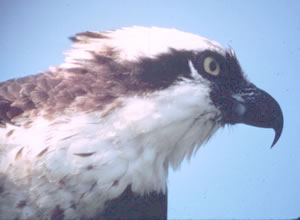 the
formation of DEP's Endangered and Nongame Species Program
(ENSP). the
formation of DEP's Endangered and Nongame Species Program
(ENSP).
The osprey is a large raptor (bird of prey) usually seen
near bodies of water that support adequate fish populations. In the 1800s, there
was an abundant breeding population of osprey along the New Jersey coast and
near most fresh water bodies. Pesticide contamination and habitat loss gradually
reduced the annual number of osprey nesting pairs throughout this past century.
In fact, osprey populations plummeted from 500 pairs in the 1950s to 68 pairs
in 1975. The species became one of the first to be included on the New
Jersey Endangered Species List.
The state's osprey population began to recover as nesting
success improved and the number of nesting pairs increased each year. Due to
its improved reproductive success, its acceptance of manmade nesting structures
and the decline of persistent pesticides, the status of the osprey in New Jersey
was changed from endangered to threatened in 1985 — the first species to
be removed from the list. Department biologists and volunteers counted 340 nests
in 2001 and banded 201 young osprey in their nests in 2002.
|
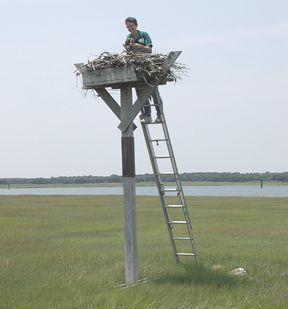
Banding chicks on tower
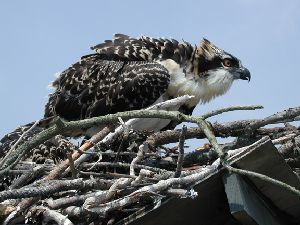
Banded chick on nest
|
The Osprey -
Brought Back From "The Brink"
- In the early 1900s, the number of reproductive
osprey pairs began to decline due to habitat loss, the eradication
of nest trees, egg collecting and shooting. This was compounded
by increased human settlement along the coast later in the century.
- Between 1946 through 1964, the pesticide
DDT was introduced into the environment to combat mosquitoes.
It entered the food chain and eventually contaminated predators
like the osprey. The chemical weakened the thickness of osprey
eggshells, which would break under the weight of the bird during
incubation.
- Osprey can experience reproductive failure
over a long period of time because DDT contamination can remain
in an adult osprey's body for years.
- In 1979, the Endangered and Nongame Species
Program transplanted eggs from healthy nests in the Chesapeake
Bay area into New Jersey nests. Program staff also erected nesting
platforms and began annual surveys to monitor osprey productivity.
- The Department currently conducts an aerial
survey of the state's osprey population every two years. They
observe nests yearly and band many of the young osprey chicks
while they are still in the nest.
|
|
Osprey – Facts of Interest
- The osprey has a wingspan of 4.5 – 6
feet. It glides with its long, narrow wings pulled towards the
body and, when viewed from the ground, resembles the shape of
the letter "M".
- The osprey's head is white with a broad,
black eye stripe that extends to the back of the neck. The underside
is white with flight and tail feathers that are dark brown with
faint white bands.
- Ospreys feed on fish and inhabit coastal
rivers, marshes and bays, as well as rivers, lakes and reservoirs.
They are known for their feet-first plunge into the water to catch
their prey with their strong toes (or talons) that have spines
on them to pierce the fish's skin.
- Ospreys nest on live or dead trees, manmade
nesting platforms, light poles, channel markers and other elevated
structures that offer an unobstructed view of the landscape near
and around a water body.
|
|
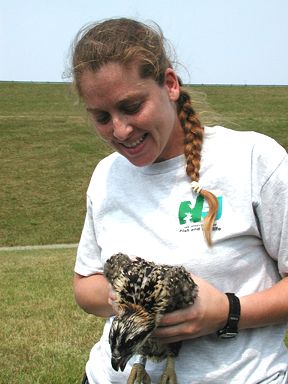
ENSP biologist with banded chick
|
| Ways
You Can Help |
| If you are
interested in volunteering to observe osprey nests, check nest results,
construct or erect new nesting platforms or help maintain existing ones,
please contact ENSP biologist Kathy Clark at 609-628-2103 or kathy.clark@dep.state.nj.us.
|
|
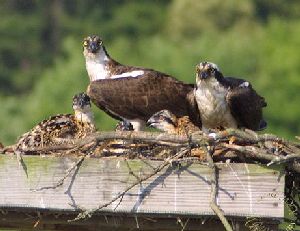
Photo courtesy of Ken Walker
|
If you have observed an active osprey
nest in inland areas, especially around the northern lakes and reservoirs
in the state, please submit the sighting information to Mike Valent at
908-735-8975. This should be done only during nesting season (April 15
- July 15). Please remember – no one should approach a nest structure
during the nesting season.
Check-off for Wildlife when completing
your state tax return each year! This is a primary funding source for the
preservation of the state's endangered and nongame wildlife.
|
|
|
Order a
Conserve Wildlife special interest license plate for your vehicle. It's
tax-deductible, with 80% of the payment benefiting New Jersey's Endangered
and Nongame Species Program. |
|
Want to volunteer? Enjoy giving presentations? Looking
for speakers? The Division of Fish and Wildlife offers two opportunities:The
Endangered and Nongame Species Program's Speakers
Bureau and the Division's Wildlife Conservation
Corps. Visit these sites for details.
|
|
|
| Additional Sources of Information |
|
|
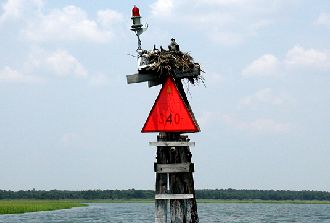 Nest on channel marker
Nest on channel marker |
|
 the
formation of DEP's Endangered and Nongame Species Program
(ENSP).
the
formation of DEP's Endangered and Nongame Species Program
(ENSP).






